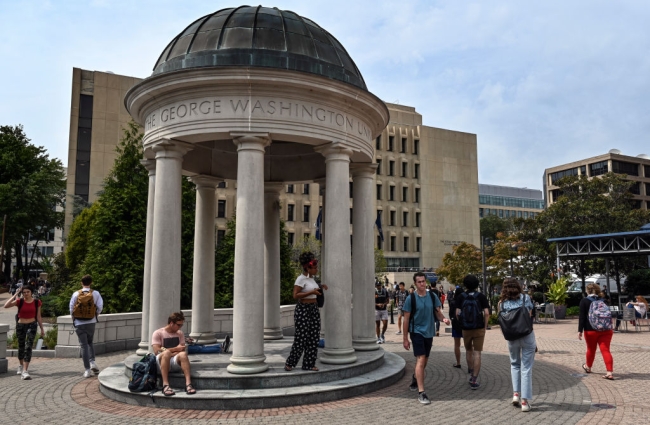You have /5 articles left.
Sign up for a free account or log in.

The Washington Post/Contributor/Getty Images
Even as colleges and universities expanded in-person instruction this spring, undergraduate enrollment continued to tumble.
Enrollment across all institution types fell by 2.9 percent this term compared with last spring, according to new preliminary data from the National Student Clearinghouse Research Center. These early numbers reveal similar declines to fall 2020, when enrollment fell by 3.3 percent year over year across the board.
The National Student Clearinghouse Research Center has tracked the COVID-19 pandemic’s impact on higher education enrollment for nearly a year. The latest data include enrollment information as of Feb. 11 from 43 percent of the institutions that normally report to the clearinghouse. The early spring enrollment data reflect 6.7 million enrolled students at public and private four-year colleges, public two-year colleges, and for-profit institutions. All the figures in this report could change as the clearinghouse collects more data this spring.
Undergraduate enrollment declined by 4.5 percent this term across all institution types, compared with last spring. This past fall, undergraduate enrollment fell by 4.4 percent. Public four-year colleges have so far seen a 3.3 percent undergraduate enrollment decline compared with last spring. Private nonprofit four-year colleges are looking at a 2 percent undergraduate enrollment dip. Meanwhile, for-profit institutions experienced a 3.9 percent bump in undergraduates this term.
“There is no quick turnaround in sight for undergraduate enrollment declines driven by the pandemic,” Doug Shapiro, executive director of the National Student Clearinghouse Research Center, said during a media briefing. “It really looks from these numbers that the December and January surge in COVID-19 is keeping students out of college through the spring term, even though most colleges are online.” Most colleges have continued to offer online learning options this semester even if they've made a push to bring some students back to the classroom.
Public two-year colleges took the biggest enrollment hit of any institution type this term. So far, public two-year colleges have seen a 9.5 percent decline, which echoes the fall decline in the sector.
“Community colleges remain by far the most affected sector of higher education,” Shapiro said. “It’s much, much worse than the decline among community college students before the pandemic, where we were seeing a reduction in enrollment of just about 1.5 percent.”
Graduate enrollment, on the other hand, has increased this term by 4.3 percent year over year across all institution types. At public four-year institutions, graduate enrollment increased by 6.2 percent, and it increased by 1.5 percent at private nonprofit four-year institutions. For-profit colleges have seen a 4 percent bump in graduate enrollment so far this spring.
Enrollment at George Washington University in Washington, D.C., has mirrored the clearinghouse data, according to Jay Goff, vice provost for enrollment at the university. Total enrollment at the private four-year institution is down 2.7 percent this semester. The university saw a similar decline last fall.
Like the clearinghouse data suggest, graduate enrollment at George Washington is climbing.
“We were already seeing an increase in the number of inquiries for graduate programs about this time last year,” Goff said. “It’s not clear if the additional interest is due to the pandemic or just a continuation of that trend we were seeing a year ago.”
So far this spring, the clearinghouse has not observed any noteworthy regional enrollment trends. Declines have been scattered across the country, Shapiro said. Alaska, Mississippi, New Mexico and South Dakota saw double-digit undergraduate enrollment declines this term. Graduate enrollment increased in 40 states, with Georgia, Maine and Mississippi experiencing the biggest graduate enrollment bumps this term.
Alaska, Arkansas, Connecticut, Indiana, Minnesota, New York and Pennsylvania saw declines in both undergraduate and graduate enrollment this spring.
Undergraduate enrollment declined for all racial and ethnic categories, according to the clearinghouse data. Native American student enrollment fell sharply this term, by 12.5 percent. Undergraduate enrollment among white students and Black students also fell by more than 7 percent this spring.
Latina enrollment at community colleges declined nearly 10 percent this spring despite gains the year prior, according to the data. Latino community college enrollment slipped even further, declining by more than 18 percent this spring. In a recent interview with The Washington Post, Deborah A. Santiago, co-founder and chief executive of Excelencia in Education, an organization dedicated to improving outcomes for Latinx students, discussed some of the reasons that Latino student enrollment was hit hardest by the pandemic.
"Because our adults tend to be blue-collar workers who have lost out in this economy, having additional hands, all able-bodied folks working, has become essential," Santiago told the Post. “Students are having to prioritize supporting their family -- going to college is another way to do that, but the immediate need has superseded the longer-term goal."
Traditional-aged student enrollment, which includes students ages 18 to 24, fell more steeply this spring compared to last, by 5.3 percent. Adult student enrollment declined by 2.6 percent this term. These declines differ somewhat by gender. Enrollment among male students fell by more than 5 percent this spring for every age group. Female student enrollment, on the other hand, declined by less than 5 percent for every age group.
As it has throughout the pandemic, international student enrollment continued to drop this spring, by more than 15 percent for undergraduate students and by 5.2 percent for graduate students.
Like many institutions, George Washington has observed falling international student enrollment. International student applications to the university are down, indicating that the decline could continue into next year.
“Although our domestic applications are up over 5 percent, our international applications are down again,” Goff said. “Freshman applications for fall 2021 set a new record this year. We were up 1.5 percent in total applications, but the increase was all domestic students.”
It’s too soon to tell whether these enrollment declines will continue into the fall, Shapiro said. But recovery likely won’t be a passive process.
“There’s still a lot more work to do,” Shapiro said. “Colleges, high schools and policy makers will need to work together to help bring learners back into higher education, particularly among disadvantaged groups who are struggling the most during the pandemic and the recession.”




